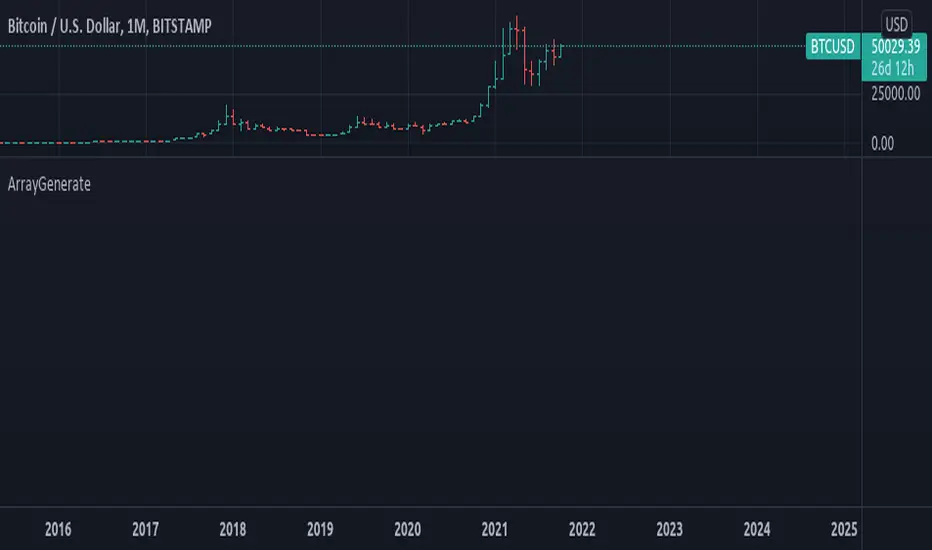PINE LIBRARY
Aggiornato ArrayGenerate

Library "ArrayGenerate"
Functions to generate arrays.
sequence_int(start, end, step) returns a sequence of int numbers.
Parameters:
Returns: int[], array.
sequence_float(start, end, step) returns a sequence of float numbers.
Parameters:
Returns: float[], array.
sequence_from_series(src, length, shift, direction_forward) Creates a array from a series sample range.
Parameters:
Returns: float array
normal_distribution(size, mean, dev) Generate normal distribution random sample.
Parameters:
Returns: float array.
log_spaced(length, start_exp, stop_exp) Generate a base 10 logarithmically spaced sample sequence.
Parameters:
Returns: float array.
linear_range(stop, start) Generate a linearly spaced sample vector within the inclusive interval (start, stop) and step 1.
Parameters:
Returns: float array.
periodic_wave(length, sampling_rate, frequency, amplitude, phase, delay) Create a periodic wave.
Parameters:
Returns: float array.
sinusoidal(length, sampling_rate, frequency, amplitude, mean, phase, delay) Create a Sine wave.
Parameters:
Returns: float array.
periodic_impulse(length, period, amplitude, delay) Create a periodic Kronecker Delta impulse sample array.
Parameters:
Returns: float array.
Functions to generate arrays.
sequence_int(start, end, step) returns a sequence of int numbers.
Parameters:
- start: int, begining of sequence range.
- end: int, end of sequence range.
- step: int, step, default=1 .
Returns: int[], array.
sequence_float(start, end, step) returns a sequence of float numbers.
Parameters:
- start: float, begining of sequence range.
- end: float, end of sequence range.
- step: float, step, default=1.0 .
Returns: float[], array.
sequence_from_series(src, length, shift, direction_forward) Creates a array from a series sample range.
Parameters:
- src: series, any kind.
- length: int, window period in bars to sample series.
- shift: int, window period in bars to shift backwards the data sample, default=0.
- direction_forward: bool, sample from start to end or end to start order, default=true.
Returns: float array
normal_distribution(size, mean, dev) Generate normal distribution random sample.
Parameters:
- size: int, size of array
- mean: float, mean of the sample, (default=0.0).
- dev: float, deviation of the sample from the mean, (default=1.0).
Returns: float array.
log_spaced(length, start_exp, stop_exp) Generate a base 10 logarithmically spaced sample sequence.
Parameters:
- length: int, length of the sequence.
- start_exp: float, start exponent.
- stop_exp: float, stop exponent.
Returns: float array.
linear_range(stop, start) Generate a linearly spaced sample vector within the inclusive interval (start, stop) and step 1.
Parameters:
- stop: float, stop value.
- start: float, start value, (default=0.0).
Returns: float array.
periodic_wave(length, sampling_rate, frequency, amplitude, phase, delay) Create a periodic wave.
Parameters:
- length: int, the number of samples to generate.
- sampling_rate: float, samples per time unit (Hz). Must be larger than twice the frequency to satisfy the Nyquist criterion.
- frequency: float, frequency in periods per time unit (Hz).
- amplitude: float, the length of the period when sampled at one sample per time unit. This is the interval of the periodic domain, a typical value is 1.0, or 2*Pi for angular functions.
- phase: float, optional phase offset.
- delay: int, optional delay, relative to the phase.
Returns: float array.
sinusoidal(length, sampling_rate, frequency, amplitude, mean, phase, delay) Create a Sine wave.
Parameters:
- length: int, The number of samples to generate.
- sampling_rate: float, Samples per time unit (Hz). Must be larger than twice the frequency to satisfy the Nyquist criterion.
- frequency: float, Frequency in periods per time unit (Hz).
- amplitude: float, The maximal reached peak.
- mean: float, The mean, or DC part, of the signal.
- phase: float, Optional phase offset.
- delay: int, Optional delay, relative to the phase.
Returns: float array.
periodic_impulse(length, period, amplitude, delay) Create a periodic Kronecker Delta impulse sample array.
Parameters:
- length: int, The number of samples to generate.
- period: int, impulse sequence period.
- amplitude: float, The maximal reached peak.
- delay: int, Offset to the time axis. Zero or positive.
Returns: float array.
Note di rilascio
v2 - Update to V6.Libreria Pine
Nello spirito di TradingView, l'autore ha pubblicato questo codice Pine come libreria open source affinché altri programmatori della nostra comunità possano riutilizzarlo. Complimenti all'autore! È possibile utilizzare questa libreria privatamente o in altre pubblicazioni open source, ma il riutilizzo di questo codice nelle pubblicazioni è soggetto al Regolamento.
Declinazione di responsabilità
Le informazioni e le pubblicazioni non sono intese come, e non costituiscono, consulenza o raccomandazioni finanziarie, di investimento, di trading o di altro tipo fornite o approvate da TradingView. Per ulteriori informazioni, consultare i Termini di utilizzo.
Libreria Pine
Nello spirito di TradingView, l'autore ha pubblicato questo codice Pine come libreria open source affinché altri programmatori della nostra comunità possano riutilizzarlo. Complimenti all'autore! È possibile utilizzare questa libreria privatamente o in altre pubblicazioni open source, ma il riutilizzo di questo codice nelle pubblicazioni è soggetto al Regolamento.
Declinazione di responsabilità
Le informazioni e le pubblicazioni non sono intese come, e non costituiscono, consulenza o raccomandazioni finanziarie, di investimento, di trading o di altro tipo fornite o approvate da TradingView. Per ulteriori informazioni, consultare i Termini di utilizzo.